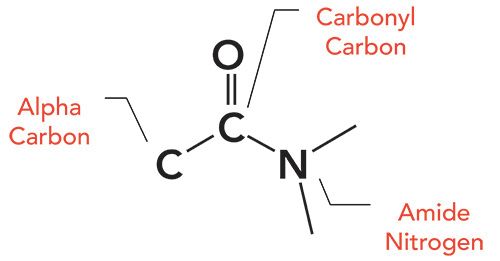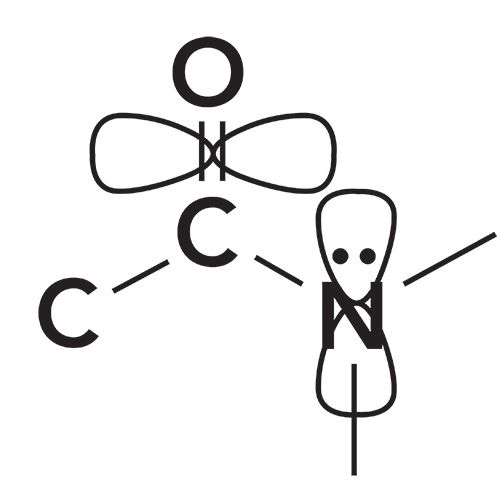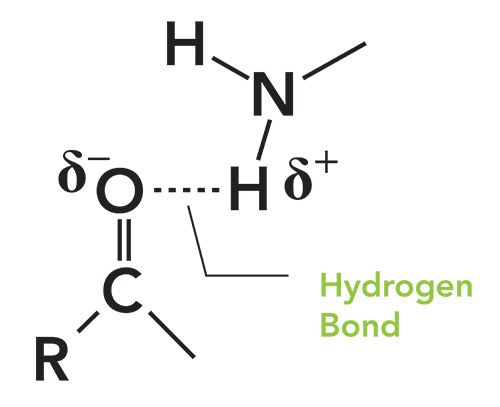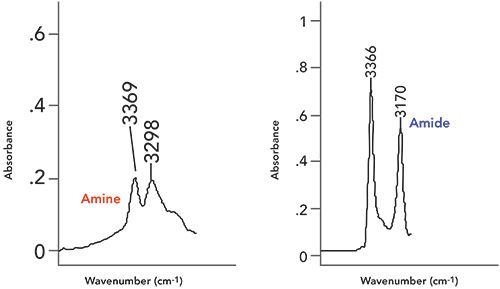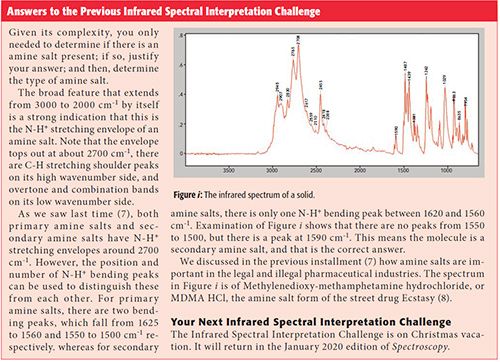Organic Nitrogen Compounds VI: Introduction to Amides
Spectroscopy
Amides are an important functional group found extensively in polymers and proteins. There are three different families of amides. Here, is explained how to distinguish them using infrared spectroscopy.
Amides are an important functional group, because they are found extensively in polymers and proteins. They are unusual in that they contain nitrogen and a carbonyl group, giving a number of useful group wavenumbers. Also, hydrogen bonding affects their spectra.
The amide functional group is important in biology and industry; every protein molecule on the planet contains amide linkages, and the backbones of the nylon family of polymers contain amide bonds. Amides are consistent with the theme of the last several columns in that they contain a nitrogen atom, but they also contain a carbonyl or C=O bond, which we have studied extensively in previous columns (1). The generic structural framework of amides is seen in Figure 1.
The first thing we have to decide is how to pronounce the word “amide.” Depending upon who I am talking to and where they are from, I have heard about nine different pronunciations for this word that, when spelled out phonetically, are: Ay-mids, Ay-mides, Ay-muds, Uh-mids, Uh-mides, Uh-muds, Am-mids, Am-mides, and Am-muds. My preferred pronunciation is “Ay-mides”, which I will use throughout the rest of this column.
The amide functional group consists of a central carbonyl group with a nitrogen atom single bonded to the carbonyl carbon. This nitrogen is called the “amide nitrogen”, and can have carbons or nitrogens attached to it. When we first started studying organic nitrogen compounds and were introduced to amines, we found that they came in three varieties, called primary, secondary, and tertiary, depending upon the number of carbons attached to the nitrogen atom (2). Similarly we speak of primary, secondary, and tertiary amides, and again the difference between them is the number of carbons attached to the nitrogen. The skeletal frameworks of primary, secondary, and tertiary amides are seen in Figure 2.
Note that, as in amines, we are counting the number of C-N bonds. Thus, a primary amide has one C-N bond and two N-H’s, a secondary amide has two C-N bonds and one N-H, and a tertiary amide has three C-N bonds and no N-H bonds. Given that this primary/secondary/tertiary terminology applies to both amines and amides, we can speak more generally of primary, secondary, and tertiary nitrogens. Therefore, when looking at the structures of amides, amines, and other nitrogen containing functional groups, a primary nitrogen will have one C-N and two N-Hs, a secondary nitrogen will have two C-N bonds and one N-H, and a tertiary nitrogen will have three C-Ns and no N-H bonds.
In previous columns when we studied carbonyl groups attached to benzene rings, we encountered the phenomenon of conjugation (3). Briefly, the pi orbital on the carbonyl group overlaps slightly with the pi electron cloud orbital on the aromatic ring, causing a small amount of electron density to be withdrawn from the carbonyl bond lowering its force constant. Spectroscopically, this is expressed as a ~30 cm-1 lowering of the position of the C=O stretch compared to a non-conjugated carbonyl (3), and we spoke of saturated and aromatic versions of carbonyl containing functional groups (3).
Amides also engage in conjugation as seen in Figure 3.
The nitrogen atom in amides contains a p-orbital with a lone pair of electrons in it. This orbital happens to point in space towards the pi-electron cloud of the carbonyl group. There is some orbital overlap here, as illustrated in Figure 3, which leads to conjugation. Like with aromatic carbonyl groups, as a result of conjugation some of the electron density is withdrawn from the carbonyl bond, weakening it and lowering its force constant. This causes the amide C=O stretch to be on the low side compared to other carbonyl containing functional groups, typically from 1680-1630 cm-1. Note, however, that we do not speak of saturated or aromatic amides as conjugation takes place in all amides so they all have the same carbonyl stretching peak range.
When we first started studying the infrared spectra of organic nitrogen compounds, we saw how hydrogen bonded to each other (4). We also discussed at length how N-H stretching peaks appear in the same wavenumber region as O-H stretching peaks, but that N-H stretching peaks are weaker and narrower than O-H stretching peaks, because the hydrogen bond strength for N-H is less than that for O-H (4). We then saw how amines hydrogen bond to each other, and what N-H stretching peaks look like (2,5). Like amines, amides also engage in hydrogen bonding, but it is structurally different than in amines, as seen in Figure 4.
Because of the electronegativity difference between carbon and oxygen, the oxygen atom in a C=O bond contains a partial negative charge, as denoted by the б- in Figure 4. Because of the electronegativity difference between nitrogen and hydrogen, the hydrogen in an N-H bond has a partial positive charge, as denoted by б+ in Figure 4. The result is that the carbonyl on one amide molecule coordinates with the N-H of a neighboring molecule, forming a hydrogen bond.
In the very first installment of this column, we learned that infrared peak widths are determined by the strength of the intermolecular interactions between neighboring molecules (6). Hydrogen bonds are an example of a strong intermolecular interaction. As a result, any functional group that engages in hydrogen bonding is going to have broadened peaks compared to non-hydrogen bonded functional groups. We saw this with amines (4), and it applies to amides as well.
Note that, to the left in Figure 5, the amine N-H stretching peaks come to a point, but are broadened at their base. Similarly, the amide N-H stretching peaks to the right in Figure 5 come to a sharp point, but are broadened at their base. Note that, for both these functional groups, the N-H stretching peaks fall in about the same place, 3400 to 3200 cm-1. This means that the N-H stretching peaks by themselves cannot be used to distinguish amides from amines. However, since amides contain a C=O bond and amines do not, these two functional groups are easy to distinguish. N-H stretches with the presence of a C=O stretch indicate amides, N-H stretches without a C=O stretch indicate amines. As we will see in the next column, primary, secondary, and tertiary amides can be distinguished from each other by infrared spectroscopy.
Conclusions
Amides are an important nitrogen containing functional group. Their structure consists of a nitrogen atom attached to a carbonyl group. There are three types of amide, primary, secondary, and tertiary depending upon the number of C-N bonds present in the group. All amides are conjugated, resulting in their all having a relatively low wavenumber C=O stretching peak. Amides also exhibit hydrogen bonding, resulting in somewhat broadened N-H stretching peaks. The three types of amides can be distinguished from each other by infrared spectroscopy as will be seen in the next column.
References
- B.C. Smith, Spectroscopy33(11), 24−29 (2018).
- B.C. Smith, Spectroscopy34(3), 22−25 (2019).
- B.C. Smith, Spectroscopy32(9), 31−36 (2017).
- B.C. Smith, Spectroscopy34(1), 10−15 (2019).
- B.C. Smith, Spectroscopy34(5), 22−26 (2019).
- B.C. Smith, Spectroscopy30(1), 16−23 (2015).
- B.C. Smith, Spectroscopy34(9), 30−37 (2019).

Brian C. Smith, PhD, is founder and CEO of Big Sur Scientific, a maker of portable mid-infrared cannabis analyzers. He has over 30 years experience as an industrial infrared spectroscopist, has published numerous peer reviewed papers, and has written three books on spectroscopy. As a trainer, he has helped thousands of people around the world improve their infrared analyses. In addition to writing for Spectroscopy, Dr. Smith writes a regular column for its sister publication Cannabis Science and Technology and sits on its editorial board. He earned his PhD in physical chemistry from Dartmouth College. He can be reached at: SpectroscopyEdit@MMHGroup.com

AI Shakes Up Spectroscopy as New Tools Reveal the Secret Life of Molecules
April 14th 2025A leading-edge review led by researchers at Oak Ridge National Laboratory and MIT explores how artificial intelligence is revolutionizing the study of molecular vibrations and phonon dynamics. From infrared and Raman spectroscopy to neutron and X-ray scattering, AI is transforming how scientists interpret vibrational spectra and predict material behaviors.
Real-Time Battery Health Tracking Using Fiber-Optic Sensors
April 9th 2025A new study by researchers from Palo Alto Research Center (PARC, a Xerox Company) and LG Chem Power presents a novel method for real-time battery monitoring using embedded fiber-optic sensors. This approach enhances state-of-charge (SOC) and state-of-health (SOH) estimations, potentially improving the efficiency and lifespan of lithium-ion batteries in electric vehicles (xEVs).
New Study Provides Insights into Chiral Smectic Phases
March 31st 2025Researchers from the Institute of Nuclear Physics Polish Academy of Sciences have unveiled new insights into the molecular arrangement of the 7HH6 compound’s smectic phases using X-ray diffraction (XRD) and infrared (IR) spectroscopy.
